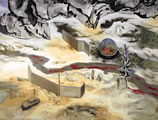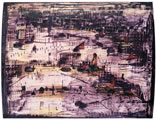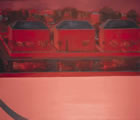Although he is described as a representative of the younger generation of English landscape painters, Christopher Cook's paintings do not emphasize landscape as such. His tableaux certainly contain elements such as trees, flowing rivers and rocky mountains but, for instance, they rarely include a horizon. And when a horizon is depicted, it tends to be located at the top of the painting. Cook tends to direct his attention earthwards, with what he terms the downward gaze. The enveloping structure is an equally important aspect. it allows him to approach his subject more closely and to render his observations in a more concentrated and intimate way. Consequently, his 'landscapes' gain in terms of singularity, and the downward gaze is transformed into an inward gaze.
This breed of autonomous painter is certainly not the latest craze. A London art world insider once remarked that Cook's work simply cannot be compared with that of any other artist. And, he added, this is not what people want. Instead they are looking for artists who react to each other and who present themselves emphatically through the media. Artists such as Rachel Whiteread, Damien Hirst and Sarah Lucas. And these are also the artists, he readily admitted, who throw themselves at the mercy of a media world that can both make and break them. By contrast Cook has simply intensified the 'idiosyncratic' character of his work.
The word idiosyncratic set me thinking. Did he mean that Cook makes work that is simply too peculiar and that does not relate to what is happening and attracting attention elsewhere? How strange to find yourself labelled an outsider when you have actually managed to boost the level of inwardship and insidership in the work!
Yet Cook is in good company in England. He was the youngest participant in a 1991 exhibition called Da Bacon a oggi I From Bacon to now that was held at the Palazzo Vecchio in Florence. Here, he was presented as an outsider alongside other British painters such as Francis Bacon, Lucian Freud, Leon Kossoff and Frank Auerbach. In fact, the introversion and concentration of Cook's work does not mean that it fails to relate to other artists' work. The Florence exhibition immediately revealed an intriguing relation between Bacon and Cook. I also noticed that Cook has much in common with at least two prominent young Dutch painters: Gijs Frieling and Rob Birza. Like them, he is deeply involved with eastern mysticism and with the desire to unite the essence of the East with the West. Their work is also blatantly decorative, it 'zooms in' on its subject matter and is acutely sensitive to both history and the history of art. Moreover, in Florence, the attentive visitor would have detected parallels with a well-known work by a local painter: Piero della Francesca.
 Here, I am referring to Cook's magnificent painting The Living And The Dead (1989). I believe that this work is central to his entire oeuvre and it also reminds me of The Dream of Constantine (1460), Della Francesca's fresco in the Church of San Francesco in Arezzo.
Here, I am referring to Cook's magnificent painting The Living And The Dead (1989). I believe that this work is central to his entire oeuvre and it also reminds me of The Dream of Constantine (1460), Della Francesca's fresco in the Church of San Francesco in Arezzo.
The painting shows the Emperor Constantine lying asleep in a circular army tent and it depicts the moment when in a dream he is converted to Christianity. The tent's interior is illuminated from above by an angel, a flaming, winged figure. This is the point of insight, of conception and ignition. Outside is darkness and war, but inside, in the dream, is the burgeoning promise of paradise.
The Living And The Dead also consists of a circular tent against a dark background. In fact, it is simply a curtain that has been opened from the front and which is suspended from a circular rod. Outside of the tent are dark and amorphous forms that look vaguely like human remains. One thing is clear: a war is raging here. But inside a fire is burning. The glow of white flames extends beyond the open circle, and higher up it turns into white smoke through which white birds are flying. Of course, it is a special fire and this too is a moment of insight, of ignition. In terms of the birds, it is as it they are the result of all this and are the messengers of what is to come.
You can explore painting more deeply by listening to the maker's language and fortunately Cook is not only a painter but also a poet. in terms of vocabulary, I was struck by two words that he used repeatedly, not in poems but in everyday speech and which I found extraordinarily beautiful. Maybe it is just projection on my part but when I look at his work they are constantly on my mind.
The first word is fervour. The 'heat' that this word implies is all but tangible in The Living and the Dead, the glow and the raging of the living fire within the confines of the tent, the inner sanctum. Outside there is mere desolation. Whilst, the second word, is more ethereal and elusive. it stands for a transitional zone and simultaneity, for the one aspect whilst at the same time the other... - for what is also occurring here. But, as Cook has remarked, fire is 'something on the point of change' so that those concepts are intertwined as well.
Fire, the process of transition, simultaneity, the tent's curtain as a mysterious intermediary figure... these elements inevitably reflect the painter himselt and his expressive medium: the painting. And it is through this inward gaze that you become truly enthralled by Cook's work. This particularly applies to a series of paintings that he began in the early nineties and which consist of curtains in landscapes that sometimes appear to contradict each other. Hence, whereas his Purification Tent (1991) includes a voile canopy tinged with ultra-violet that ends with a view of a landscape, in Shroud (1991) the tinge has turned purple and the curtain has been purposely placed right in the middle of the landscape like an enormous wall. Later on, curtains could be taken for fences and walls, for straightforward barriers. Or could they?
The recent series of works from 1996 and 1997 also displays this ambivalence, this convergence of diverse worlds within one and the same framework that creates a sense of the unexpected. Each painting contains two worlds, both inner and outer, here and elsewhere, the geometric and the shamelessly decorative. Why am I particularly struck by the red in those works? Is it because Cook has so emphatically called them 'colourworks' so as to distinguish them from the subsequent, grey graphite paintings?
 In Spectacle (1997), a striking dividing line runs through an inhospitable landscape: a stream of flaming grey-red. Behind it is a 'snowball' or pleasure dome. Normally this is a small glass half-ball that fits in the palm of your hand and which 'snows' when you shake it. But Cook's version is more than that: it is a complete microcosm. He painted a whole series of these works in 1994. Each 'dome' coincides exactly with the painting's contours. Their contents include anything from a pilgrimage mountain to an industrial area or a Madonna and Child. In Spectacle, the 'snowball' functions as an ideal inner world in desolate surroundings. It contains an idyllic scene of Adam and Eve in paradise. They are being observed with amazement by a group of spectators on the other side of the stream. A car has been parked next to a group of strangely located blank walls and high lamp-posts. These evoke a sense of urban isolation or the atmosphere of the wastelands just beyond the city boundary: a no-man's-land with no particular identity. As yet there are still no surveillance cameras. instead an absurd looking fence with a litter bin completes the sense of dislocation. An exotically-plumed and displaced tree of paradise feeds the stream with its bleeding trunk.
In Spectacle (1997), a striking dividing line runs through an inhospitable landscape: a stream of flaming grey-red. Behind it is a 'snowball' or pleasure dome. Normally this is a small glass half-ball that fits in the palm of your hand and which 'snows' when you shake it. But Cook's version is more than that: it is a complete microcosm. He painted a whole series of these works in 1994. Each 'dome' coincides exactly with the painting's contours. Their contents include anything from a pilgrimage mountain to an industrial area or a Madonna and Child. In Spectacle, the 'snowball' functions as an ideal inner world in desolate surroundings. It contains an idyllic scene of Adam and Eve in paradise. They are being observed with amazement by a group of spectators on the other side of the stream. A car has been parked next to a group of strangely located blank walls and high lamp-posts. These evoke a sense of urban isolation or the atmosphere of the wastelands just beyond the city boundary: a no-man's-land with no particular identity. As yet there are still no surveillance cameras. instead an absurd looking fence with a litter bin completes the sense of dislocation. An exotically-plumed and displaced tree of paradise feeds the stream with its bleeding trunk.
 The atmosphere is even more pitiless in War-torn (1997). It suggests a battlefield in which the grid evokes not only isolation but also the enlarged structure of cloth, and this could be a reference to the texture of canvas. Here, light and dark battle it out, and there is the occasional blaze of red, wing-like fire. Those forms are reminiscent of the bleeding tree of paradise.
The atmosphere is even more pitiless in War-torn (1997). It suggests a battlefield in which the grid evokes not only isolation but also the enlarged structure of cloth, and this could be a reference to the texture of canvas. Here, light and dark battle it out, and there is the occasional blaze of red, wing-like fire. Those forms are reminiscent of the bleeding tree of paradise.
 The skies in The Portable Shrine (1996) are also blood-red, at least they are in the inner world of yet another 'snowball' containing a bloody stump, the remains of what was once human life, a relic. It is located in the middle of a battlefield: an area of desolation in grey where red merely serves as a detail on canons, rapists and people who have been mutilated in various different ways. But is this really Cook's intended synthesis of inner and outer worlds?
The skies in The Portable Shrine (1996) are also blood-red, at least they are in the inner world of yet another 'snowball' containing a bloody stump, the remains of what was once human life, a relic. It is located in the middle of a battlefield: an area of desolation in grey where red merely serves as a detail on canons, rapists and people who have been mutilated in various different ways. But is this really Cook's intended synthesis of inner and outer worlds?
 For a long time Cook had his doubts about a slightly earlier painting After the Rain (1996) which seemed to be an outsider in his oeuvre. Whereas his normal approach is fragile and ethereal, this work emphasizes the powerful, concrete and solid - and, I would suggest, fervour. Three flame-red houses are located in equally red surroundings. in front of the houses 'runs' a blue road in which reflections suggest something streaming past. Could it be traffic? Or thoughts? Or time? Below this is a pink field. There is a strong contrast between the closed and statically-burning houses and the streaming track yet they are connected by the use of the colour red: the movement of the stream is as red as that of the triple burning corpus that appears to be bathing in its own isolation. The painting appears to be no outsider. On the contrary. it's a next step forwards - and inwards.
For a long time Cook had his doubts about a slightly earlier painting After the Rain (1996) which seemed to be an outsider in his oeuvre. Whereas his normal approach is fragile and ethereal, this work emphasizes the powerful, concrete and solid - and, I would suggest, fervour. Three flame-red houses are located in equally red surroundings. in front of the houses 'runs' a blue road in which reflections suggest something streaming past. Could it be traffic? Or thoughts? Or time? Below this is a pink field. There is a strong contrast between the closed and statically-burning houses and the streaming track yet they are connected by the use of the colour red: the movement of the stream is as red as that of the triple burning corpus that appears to be bathing in its own isolation. The painting appears to be no outsider. On the contrary. it's a next step forwards - and inwards.
Conversation in the studio with Cook in Exeter, July 1997